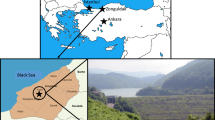Abstract
Dam failure has been the subject of many hydraulic engineering studies due to its complicated physics with many uncertainties involved and the potential to cause many losses of lives and economical losses. A primary source of uncertainties in many dam failure analyses refers to prediction of the reservoir’s outflow hydrograph, which is studied in the present investigation. This paper presents an experimental study on instantaneous dam failure flood under different reservoir’s capacities and lengths in which the side slopes change within a range of 30°–90°. Thus, several outflow hydrographs are calculated and compared. The results reveal the role of the side slopes on dam break flood wave, such that lower side slope creates more catastrophic outflow. The reservoir capacity and length are also recognized to be important factors, such that they do affect peak discharge and time to peak of the outflow hydrograph. Finally, the paper presents two simple relations for peak discharge and maximum water level estimation at any downstream location.













Similar content being viewed by others
References
Xu F, Yang X and Zhou J 2015 Experimental study of the impact factors of natural dam failure introduced by a landslide surge. Environ. Earth Sci. 74(5): 4075–4087
Singh V 1996 Dam breach modelling technology. Dordrecht: Kluwer
Wahl T L 2004 Uncertainty of predictions of embankment dam breach parameters. J. Hydraul. Eng. 130(5): 389–397
Thornton C I, Pierce M W and Abt S R 2011 Enhanced predictions for peak outflow from breached embankment dams. J. Hydrol. Eng. 16(1): 81–88
Bazin H 1865 Recherches Expérimentales relatives aux remous et à la propagation des ondes [Experimental research on the hydraulic jump and on wave propagation]. Deuxième partie des Recherches hydrauliques de Darcy et Bazin, p 148
Ritter A 1892 Die Fortpflanzung der Wasserwellen [The propagation of water waves]. Z. Ver. Dtsch. Ing. 36(33): 947–954
Dressler R F 1952 Hydraulic resistance effect upon the dam-break functions. J. Res. Natl. Bur. Stand. 49(3): 217–225
Su S T and Barnes A H 1970 Geometric and frictional effects on sudden releases. J. Hydraul. Div. 96(11): 2185–2200
Pilotti M, Tomirotti M, Valerio G and Bacchi B 2010 Simplified method for the characterization of the hydrograph following a sudden partial dam break. J. Hydraul. Eng. 136(10): 693–704
Feizi Khankandi A, Tahershamsi A and Soares-Frazão S 2012 Experimental investigation of reservoir geometry effect on dam-break flow. J. Hydraul. Res. 50(4): 376–387
Hooshyaripor F and Tahershamsi A 2015 Effect of reservoir side slopes on dam-break flood waves. Eng. Appl. Comput. Fluid Mech. 9(1): 458–468
Ponce V M 1982 Documented cases of earth dam breaches. In: SDSU Civil Engineering Series. San Diego, CA: San Diego State University
Lauber G and Hager W H 1998 Experiments to dambreak wave: horizontal channel. J. Hydraul. Res. 36(3): 291–307
Taher-shamsi A, Ponce V M and Shetty A V 2003 Embankment dam breaching: geometry and peak outflow characteristics. Dam Eng. 14(2): 73–82
Leal J G A B, Ferreira R M L and Cardoso A H 2009 Maximum level and time to peak of dam-break waves on mobile horizontal bed. J. Hydraul. Eng. 135(11): 995–999
Vischer D L and Hager W H 1998 Dam hydraulics. Chichester: Wiley
SonTec 2007 User guide of Horizon ADV/YSI MicroADV. Available from http://www.sontek.com
Oertel M and Bung D B 2012 Initial stage of two-dimensional dam-break waves: laboratory versus VOF. J. Hydraul. Res. 50(1): 89–97
Escande L, Nougaro J, Castex L and Barthet H 1961 Influence de Quelques Paramètres sur une Onde de Crue Subite à l’Aval d’un Barrage (The influence of certain parameters on a sudden flood wave downstream from a dam). J. Houille Blanche 5: 565–575
Zhao W, Chen X, You Y and Chen J 2015 Dam-break characteristics of landslide dams with different types of open channel discharge sections. Environ. Earth Sci. 74(6): 5331–5340
Author information
Authors and Affiliations
Corresponding author
Rights and permissions
About this article
Cite this article
Hooshyaripor, F., Tahershamsi, A. & Razi, S. Dam break flood wave under different reservoir’s capacities and lengths. Sādhanā 42, 1557–1569 (2017). https://doi.org/10.1007/s12046-017-0693-x
Received:
Revised:
Accepted:
Published:
Issue Date:
DOI: https://doi.org/10.1007/s12046-017-0693-x




